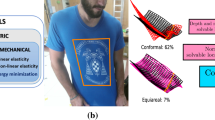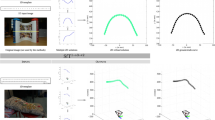Abstract
We propose models of 3D shape which may be viewed as deformable bodies composed of simulated elastic material. In contrast to traditional, purely geometric models of shape, deformable models are active—their shapes change in response to externally applied forces. We develop a deformable model for 3D shape which has a preference for axial symmetry. Symmetry is represented even though the model does not belong to a parametric shape family such as (generalized) cylinders. Rather, a symmetry-seeking property is designed into internal forces that constrain the deformations of the model. We develop a framework for 3D object reconstruction based on symmetry-seeking models. Instances of these models are formed from monocular image data through the action of external forces derived from the data. The forces proposed in this paper deform the model in space so that the shape of its projection into the image plane is consistent with the 2D silhouette of an object of interest. The effectiveness of our approach is demonstrated using natural images.
Similar content being viewed by others
References
D. Terzopoulos, “Multilevel computational processes for visual surface reconstruction,” Computer Vision, Graphics, and Image Processing, vol. 24, pp. 52–96, 1983.
T.O. Binford, “Visual perception by a computer,” Presented at the IEEE CONF. ON SYSTEMS AND CONTROL, Miami, Fla., 1971.
A. Barr, “Superquadrics and angle-preserving transformations,” IEEE Computer Graphics and Applications, vol. 18, pp. 21–30, 1981.
A.P. Pentland, “Parts: Structured descriptions of shape,” in PROC. NAT. CONF. ARTIF. INTEL., AAAI-86, Philadelphia, Pa., 1986, pp. 695–701.
J.M. Brady and H. Asada, “Smoothed local symmetries and their implementation,” Int. J. Robotics Res., vol. 3, pp. 33–61, 1984.
A. Witkin, M. Kass, D. Terzopoulos, and A. Barr, “Linking perception and graphics: Modeling with dynamic constraints,” in IMAGES AND UNDERSTANDING, H. Barlow, C. Blakemore, and W. Weston-Smith (eds.), Cambridge University Press, in press.
D. Terzopoulos, “Regularization of inverse visual problems involving discontinuities,” IEEE Trans. Pami, vol. 8, pp. 413–424, 1986.
G.A. Agin and T.O. Binford, “Computer description of curved objects,” in PROC. THIRD INT. JOINT CONF. ARTIF. INTELL., Stanford, Calif., 1973, pp. 629–635.
J.M. Hollerbach, Hierarchical shape description of objects by selection and modification of prototypes, M.I.T. Artif. Intel. Lab., Cambridge, Mass., AI-TR-346, 1975.
R. Nevatia and T.O. Binford, “Description and recognition of curved objects,” Artificial Intelligence, vol. 8, pp. 77–98, 1977.
D. Marr, “Analysis of occluding contour,” Proc. R. Soc. (London), B, vol. 197, pp. 441–475, 1977.
D. Marr and H.K. Nishihara, “Representation and recognition of the spatial organization of three-dimensional shapes,” Proc. R. Soc. (London), B, vol. 200, pp. 269–294, 1978.
R.A. Brooks, “Symbolic reasoning among 3-D models and 2-D images,” Artificial intelligence, vol. 17, pp. 285–348, 1981.
G.K. Rao and R. Nevatia, “Generalized cone descriptions from sparse 3-D data,” PROC. DARPA IMAGE UNDERSTANDING WORKSHOP, Miami Beach, Fla., L.S. Baumann (ed.), 1985, pp. 497–505.
H.A. Blum, “A transformation for extracting new descriptions of shape,” in PROC. SYMP. MODELS PERCEPT. SPEECH VISUAL FORM, Boston, Mass., 1964, pp. 362–380.
T. Kanade, “Recovery of the three dimensional shape of an object from a single view,” Artificial Intelligence, vol. 17, pp. 409–460, 1981.
J.M. Brady, “Criteria for representations of shape,” in Human and Machine Vision, A. Rosenfeld and J. Beck (eds.), Academic Press, New York, NY, 1983, pp. 39–84.
W.A. Richards and D.D. Hoffman, “Codon constraints on closed 2D shapes,” Computer Vision, Graphics, and Image Processing, vol. 31, pp. 265–281, 1985.
M. Leyton, “Constraint theorems on the prototypification of shape,” PROC. NAT. CONF. ARTIFI. INTEL., AAAI-86, Philadelphia, Pa., 1986, pp. 702–706.
M.A. Fischler and R.A. Elschlager, “The representation and matching of pictorial structures,” IEEE Trans. Computers, C-22, pp. 67–92, 1973.
A.H. Barr, “Global and local deformations of solid primitives,” Computer Graphics, vol. 18(3), pp. 21–29, 1984 (Proc. SIGGRAPH'84).
A.P. Pentland, “Recognition by parts,” PROC. FIRST INT. CONF. COMPUTER VISION, London, UK, 1987. pp. 612–620.
Y.C. Fung, Foundations of solid mechanics. Prentice-Hall: Englewood Cliffs, NJ, 1965.
G. Dahlquist and A. Björck, Numerical Methods, N. Anderson (trans.), Prentice-Hall: Englewood Cliffs, NJ, 1974.
A. Witkin, D. Terzopoulos and M. Kass, “Signal matching through scale space,” Int. J. of Computer vision, vol. 1(2), pp. 133–144, 1987.
D. Terzopoulos, “On matching deformable models to images: Direct and iterative solutions,” Topical Meeting on Machine Vision, Technical Digest Series, vol. 12. Optical Society of America: Washington, D.C., March, 1987, 160–167.
D. Terzopoulos, A. Witkin, and M. Kass, “Energy constraints on deformable models: recovering shape and non-rigid motion,” PROC. SIXTH NAT. CONF. ARTIFI. INTEL., AAAI-87, Seattle, Wash., July, 1987, pp. 755–760.
D. Rosenberg, M.D. Levine, and S.W. Zucker, “Computing relative depth from occlusion cues,” PROC. FOURTH INT. J. CONF. PATTERN RECOGNITION, Tokyo, 1978.
D. Terzopoulos, “Integrating visual information from multiple sources,” in From Pixels to Predicates: Recent Advances in Computational and Robotic Vision, A.P. Pentland (ed.). Ablex: Norwood, NJ, 1986, pp. 111–142.
D.G. Lowe, Perceptual Organization and Visual Recognition, Kluwer: Boston, Mass., 1985.
D. Terzopoulos, J. Platt, A. Barr, and K. Fleischer, “Elastically, deformable models,” Computer Graphics, 3 vol. 21, 1987, (Proc. SIGGRAPH'87), pp. 205–214.
Author information
Authors and Affiliations
Rights and permissions
About this article
Cite this article
Terzopoulos, D., Witkin, A. & Kass, M. Symmetry-seeking models and 3D object reconstruction. Int J Comput Vision 1, 211–221 (1988). https://doi.org/10.1007/BF00127821
Issue Date:
DOI: https://doi.org/10.1007/BF00127821




